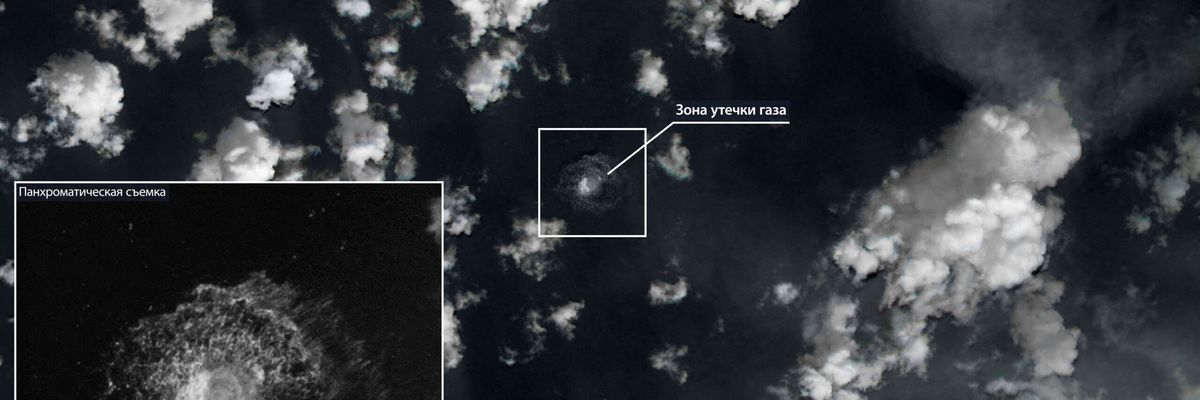Move over Sy Hersh, the White House has its own theory about the sabotage of the Nord Stream pipelines back in September 2022.
But not everyone, at least right now, is buying it — including German officials, who seem completely taken aback by Tuesday’s New York Times report, which said “new intelligence” suggests a “pro-Ukrainian group” might have been behind the sabotage.
In a German Deutsche Welle (DW) report Wednesday morning, German Defence Minister Boris Pistorius “warned against premature accusations of responsibility for the attacks.”
"It may just as well have been a false flag operation staged to blame Ukraine, an option brought up in the media reports as well," Pistorius told German public broadcaster Deutschlandfunk. Meanwhile, German Foreign Minister Annalena Baerbock “echoed the same caution, saying investigations by the relevant authorities must be concluded first,” saying Wednesday that Berlin would not "jump to conclusions" until the federal prosecution's investigation is concluded.
Meanwhile, other German joint reporting by public broadcasters ARD and SWR and Die Zeit have been conducting their own investigation, which in part fleshes out the information offered by the anonymous sources in the NYT story. According to German paper Taggesshau (translated from German):
Specifically, according to information from the ARD capital studio , "Kontraste", SWR and "ZEIT", the investigators succeeded in identifying the boat that was allegedly used for the secret operation. It is said to be a yacht rented from a company based in Poland, apparently owned by two Ukrainians. According to the investigation, the secret operation at sea was carried out by a team of six people. It is said to have been five men and one woman.
Accordingly, the group consisted of a captain, two divers, two diving assistants and a doctor, who are said to have transported the explosives to the crime scenes and placed them there. The nationality of the perpetrators is apparently unclear. (They) used professionally forged passports, which are said to have been used, among other things, to rent the boat.
According to the investigation, the command set sail from Rostock on September 6, 2022
As with the NYT article, there is no confirmation offered on the nationalities of the alleged saboteurs, or any evidence that President Zelensky or his top officials were aware of the plot. Ukrainian authorities, by the way, have been adamant that their government has no ties to the explosions.
The NYT report comes nearly a month to the day that Sy Hersh published his own explosive theory in an extensively reported piece on its Substack newsletter. In it, he alleges that a small group of expert U.S. Navy divers secretly carried out the explosions on behalf of top Washington officials who wanted to take the pipelines offline after the February 2022 Russian invasion. The story was rejected as complete "fiction" by government officials and roundly ignored by the mainstream media.
Interestingly, the NYT report says "the explosives were most likely planted with the help of experienced divers who did not appear to be working for military or intelligence services, U.S. officials who have reviewed the new intelligence said. But it is possible that the perpetrators received specialized government training in the past." (emphasis mine)
The German news investigation claims the boat that was used in the operation was launched from Rostock, Germany. Hersh's report claims the boat (a minesweeper) carrying the U.S. Navy divers launched from Bornholm Island in Denmark. Moreover, while critics of Hersh's report say no minesweeper by Hersh's description was tracked on publicly available radar on the day in question, the NYT says this:
According to a European lawmaker briefed late last year by his country’s main foreign intelligence service, investigators have been gathering information about an estimated 45 “ghost ships” whose location transponders were not on or were not working when they passed through the area, possibly to cloak their movements.
George Beebe, former CIA officer and now head of Quincy Institute's Grand Strategy program suggested the timing of Tuesday's reports didn't quite pass the smell test.
"It is suspicious to me that suddenly this intelligence comes to light — many months after the fact. It’s odd, and it very conveniently serves as an alternative to Sy Hersh's reporting," he tells me. "One could perhaps explain it but it very much begs the question, where did this come from, and why now?"
Foreign policy analysts and reporters had similar reactions on Tuesday. Jack Murphy, a Special Operations veteran, author, and journalist who in December broke a story about CIA-backed, pro-Ukraine saboteurs operating in Russia, seemed incredulous that if it were a pro-Ukrainian group, the U.S. wouldn't know about it.
"Still scratching my head over this one," he wrote on Twitter. "So, I'm to believe we cracked Russian military comms, have sources in the Kremlin, are 3 steps ahead of them, but... We have "limited visibility" into the decision making process of the Ukrainians, and are frustrated by their renegade ops?"
Others puzzled over the idea that a seemingly rogue group could be responsible for a sophisticated operation that investigators said could likely only be pulled off by a state actor — and only a handful of states at that. While investigations have been ongoing, Russia's culpability — which had been suggested from the get-go by American officials, punditry and media — has been all but written off.
If this is some sort of false flag — traces left to suggest Ukrainian involvement — why?
"The Biden administration seems to be recognizing that the story of the Russians blowing up their own pipeline wasn’t holding any water," said Beebe.
"This doesn’t mean (the NYT story) is wrong, but it sure does raise questions in my mind as to what is going on here. They didn’t show any evidence to the New York Times reporters, they simply said, ‘we have this new intelligence. Trust us.”
















